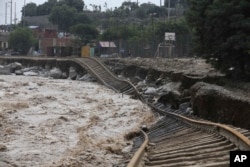Peruvians are struggling to cope with avalanches, mudslides and extensive flash flooding caused by torrential downpours that killed have at least 75 people and left more than 100,000 homeless since January.
In the Peruvian capital, Lima, residents lined up for drinking water Sunday after clogged water treatment systems caused restrictions on running water.
Schools have been closed in Lima and, with some areas without running water for three days, supermarkets are reporting a shortage of bottled water.
A sudden and abnormal warming of Pacific waters off Peru has unleashed the deadliest heavy rains in decades with raging rivers sweeping away people and vehicles, clogging highways and destroying crops. Air travel has also been affected.
The rainy season has delivered 10 times more rainfall than usual. Authorities have declared half the country in emergency to expedite resources to the hardest hit areas.
The National Emergency Operations Center said 99,475 Peruvians had lost everything since the beginning of the year, while 626,928 had suffered less serious damage to their homes. And there is more to come as forecasters predict more rain ahead.
Humanitarian aid, from the government and individuals, was being sent by plane or ship to affected areas.
Peruvian President Pedro Pablo Kuczynski affirmed he is coordinating international assistance to address the emergency in the country.
"We must help each other in solidarity with those who are victims," Kuczynski said, adding that every state minister has been tasked to coordinate aid in a determined region, and that National Civil Defense Institute, Armed Forces, and National Police are working constantly to cope with the difficult situation.









